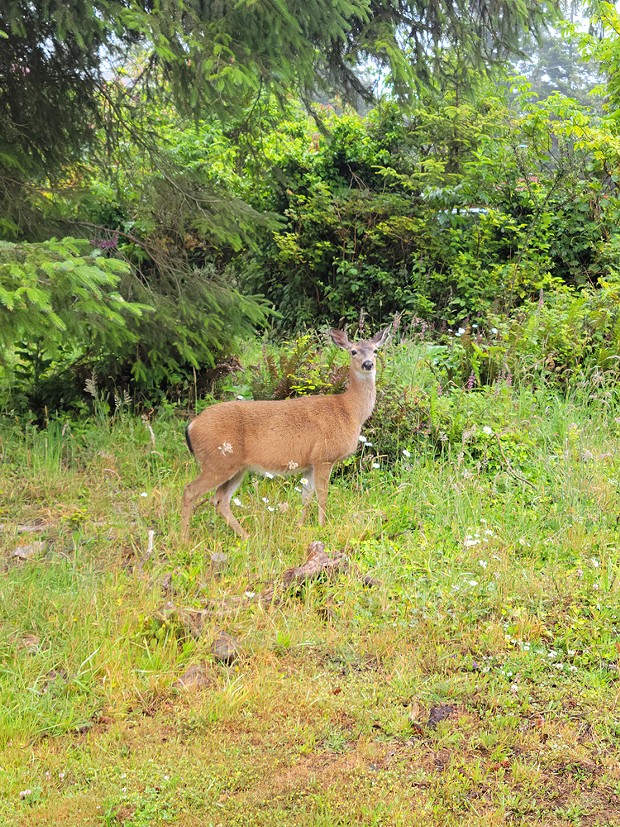[
{
"name": "Top Stories Video Pair",
"insertPoint": "7",
"component": "17087298",
"parentWrapperClass": "fdn-ads-inline-content-block",
"requiredCountToDisplay": "1"
}
]
Given the title of this article, you might think I'm going to talk about tomato hornworms, spittle bugs or aphids. OK, I will mention aphids but I want to talk to some of the less talked about pests.
Let's start with my worst pest for the past couple years: deer. Bambi. Rats with antlers, as I've heard them called. Though I prefer the term cloven hooved devil spawn.
Sure, they're cute when they stand there, staring as you slowly drive by and hope they don't suddenly jump out on the road, thus ending their destruction, but also your car. The little spotted fawns? Adorbs! Until they start munching on your prized roses. Did you know roses are ranked No. 1 on the menu for Deer DoorDash?
How to deter deer is the question. The only thing that seems to work well is an 8-foot fence and I'm talking secure fencing. T-posts and plastic deer fencing work well until it doesn't. A branch can fall on the fence, leading to an incursion of CHDS (cloven hooved devil spawn). Cattle panels work great but it's a little pricey to fence an acre or more. Some folks prefer to use a strong smelling soap like Irish Spring. Others like the deer repellent available at local nurseries. I admit those deter me because they rather reek of rotten eggs, which happens to be one of the ingredients. You can make your own deer repellent but you must reapply regularly, especially if it's rained or misted.
Fence. It's the only sure deterrent but it must be secure. Deer will crawl under fencing that isn't stapled down. Ask me how I know. OK, dogs are also a deterrent but unless you have a real livestock guardian dog and you don't mind Rover staying out all night in your yard, we're back to — yup — fence.
You could also plant things deer don't like or prefer to eat. What plants do deer not like? I HAVE NO IDEA BECAUSE THEY EAT EVERYTHING IN MY GARDEN. Well, not everything. They don't like dahlias, believe it or not, nor squash plants, though they may take a nibble here or there. Rhododendrons and azalea are also not high on the list of favorite plants for deer. Ask your local nursery staff if they have ideas or suggestions. I always joke that if they want to find out if a plant is truly deer resistant, they can give me one to plant in my yard/garden and I'll get back to them.
Next on my hit list? Nemesis No. 2: gophers. Those little rodents can clear out an entire bed of garlic if it's not protected by hardware cloth. Not chicken wire, which rusts out in just a few years. Raised beds with hardware cloth are the only way I've found to deter those little buck-toothed munchers. Unless you happen to have a great blue heron hanging around, because they love to hunt ground-dwelling rodents. You can also use traps. Some don't kill the buggers but most do. I know, I know. I'm not fond of killing wildlife to have a garden. But if you choose to draw a line in the mulch, my preferred traps are those black tube ones or the GopherHawk, which is the best by far. You can find those in local nurseries and you don't even have to touch the rodent once the trap has done its job.
Next up? Mosquitoes. You may have noticed an excess of mosquitoes here on the coast this spring and summer. Our late rains and drizzle over the past couple of months mean the mosquitoes are out in force. Did you know that they can reproduce in as little as a bottle cap of water? They can. There's probably standing water in your gutters, in your garden pots or perhaps a tarp covering firewood. You need to dump all that water out. If you have a pond or trough with water in it, you can use BT (Bacillus thuringiensis), which is safe for fish, pets, birds and other wildlife. It comes in "dunks," pellets and liquid form. Read the label to find out the proper amount to use.
Also, encourage bats in your yard or garden. Bat houses can be mounted under the eaves of the south end of your house. It helps if it's near a water source and more than 10 feet off the ground — 20 feet is ideal, but not everyone has a two-story house. A single bat will eat between 6,000-8,000 insects per night — that's a lot of mosquitoes.
Oh, let's not forget aphids. I've heard from friends and clients that it's a bad year for aphids. Easy peas-y. Spray the affected plant with a strong blast of water from a garden hose. Then encourage ladybugs to come to your yard. No herbicides, no pesticides. Plant things ladybugs adore, such as dill, parsley and fennel, and you'll attract them to eat those aphids, too.
Gardening is a messy business but there are ways to better coexist with wildlife, and keep them away from your precious roses and tomatoes.
Julia Graham-Whitt (she/her) is owner and operator of the landscaping business Two Green Thumbs.
Comments
Showing 1-1 of 1
more from the author
-
Working it Out in the Garden
- Jan 18, 2024
-
Winter Planting for Future Color
- Dec 21, 2023
- More »
































